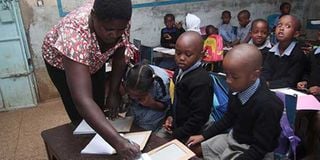Plan well for 8-4-4 to CBC transition

A teacher instructing Grade One pupils. PHOTO | FILE | NATION MEDIA GROUP
What you need to know:
- First, the Standard Four 8-4-4 class of 2019 has about 1,200,000 pupils, according to statistics from the Ministry of Education.
- The second challenge is the method to be used to select the students joining secondary school from Grade Six.
- Every secondary school will then be 50 per cent larger than it was before the CBC.
On August 16, President Uhuru Kenyatta announced that pupils will not sit an examination on completion of Grade Six and, therefore, they will automatically transition to Junior Secondary 1 under the Competency-Based Curriculum (CBC).
He also said that Junior Secondary 1, 2 and 3 will be domiciled in the secondary school tier of the system.
That is exciting. It will lead to the fulfilment of the Millennium Development Goal on provision of a 12-year basic education for every child in Kenya.
It also marks the beginning of a 10-year journey of transition from the 8-4-4 system of education to the CBC.
ANXIETIES
There will be anxieties, triumphs and financial and non-financial issues during this transition period. Let us consider a few of these.
First, the Standard Four 8-4-4 class of 2019 has about 1,200,000 pupils, according to statistics from the Ministry of Education. These children’s families have aspirations, hopes, anxieties and fears about their kin since they are the last class of a system that is being phased out.
In our zeal to embrace and praise the CBC, we could inadvertently instil a negative perception about 8-4-4, to the extent that this last class of the ‘old’ system feels rejected by society.
This feeling could be exacerbated by the fact that, in 2023, the first CBC class will transit to junior secondary school without sitting an exam as their 8-4-4 peers sweat it out in Standard Eight preparing for the last KCPE as they expect to join Form One in 2024.
SELECT STUDENTS
This unusual occurrence of a junior overtaking a senior will be corrected in 2027, when the last 8-4-4 class will complete secondary education and the pioneer CBC cohort will have one more year to go at the senior secondary school level.
But the psychological adjustments these two sets of students have to undergo is something parents, teachers and education officials have to think through and be prepared to handle as the pupils will be interacting in the same secondary schools at their formative adolescent age.
The second challenge is the method to be used to select the students joining secondary school from Grade Six. Ordinarily, this is a very competitive and emotive issue even when KCPE results were performance indicators to be used to select candidates to secondary schools. Without an exam, parents and pupils could be at a loss on how this matter will be settled.
This is one item that the task force appointed by the Cabinet Secretary for Education to spearhead the implementation of CBC have to solve and provide an objective, verifiable and credible selection method.
TRANSITION
The third challenge relates to infrastructure. A single-stream secondary school with four classrooms in 2022 will require five classrooms in 2023 and six in 2024 due to the double intake that will be occasioned by the transition from the 8-4-4 system to the CBC.
Every secondary school will then be 50 per cent larger than it was before the CBC.
This implies that dormitories, ablution blocks, laboratories and other amenities have, likewise, to be increased by at least half. The number of teachers also has to be increased by a similar or larger margin, considering that the CBC is oriented towards skills development and would, therefore, require a lower teacher-pupil ratio.
INCREASE CAPITATION
On matters finance, the government will have to budget for a 50 per cent increase in capitation as the secondary school level.
These challenges, however, are not insurmountable. Boards of management and political leaders may need to consider some measures to ameliorate the challenges.
First, every secondary school board may need to negotiate with their peers in the neighbouring primary school for use of the two available classrooms that would be vacated by the outgoing Standard Seven and Eight 8-4-4 pupils.
Secondly, communities may need to add day secondary schools. Thirdly, some boarding schools may wish to consider enrolling day scholars.
Fourthly, day schools in densely populated areas may have to introduce a shift system of teaching and learning. This entails a set of students and teachers starting classes at, say, 4am and ending at midday.
STRATEGIC PLANS
The next set would start school at 1pm and ends at 10pm in the same school, utilising the same facilities.
The shifts could then be rotated weekly or bi-weekly for purposes of students and teachers experiencing similar conditions of teaching and learning.
School boards may need to deliberate upon these issues as they review their strategic plans. And they surely must, even as they await guidance from the task force. Every school has unique circumstances that the task force report may not address conclusively.
Mr Sogomo is a former Secretary of the TSC. [email protected]





